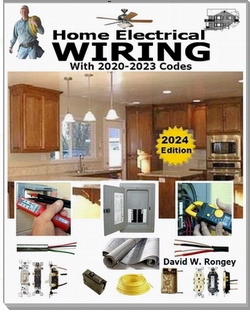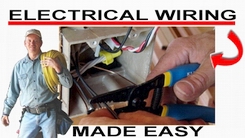» Need Electrical Help? Ask the Electrician
Garage Wiring Project
 |
By Dave Rongey
Summary: Electrical Wiring Question: I have been attempting to rewire parts of my garage, so I could have drywall hung. The box in the picture contains 4 wires. © By: Dave Rongey |
How to Rewire a Garage
Electrical Troubleshooting Question:
I have been attempting to rewire parts of my garage, so I could have drywall hung. The box in the picture contains 4 wires. The two wires on the left appear to come from inside the house. The two wires on the right run to outlets (plugs) and one of those continues on to another outlet.
When I originally opened this box (actually I replaced the box with a new one .anyway) There was five wires running into the box and a light fixture attached to it. I have since removed one of the wires, it was attached to a switch on the wall. I also decided to not add a new light fixture back onto this box to try to limit the number of wires running into it.
Of the remaining four wires, one outlet work and one does not. Also an additional outlet in the garage and two outlets in the bathroom no longer work. When I originally opened this box, the outlet that is no longer working was attached to the light fixture. And one additional white wire was attached to the light fixture and just \ twisted\ in among the other white wires.
There was also one black wire \ twisted\ in with the white wires. It was my understanding that white go to white and black to black and grounds to grounds. Which is what I did. However, now I have outlets that don't work. So, I'm assuming that one black wire should be with the white wires. How do I determine which black wire goes with the white wires or is there another problem?
Do I need to attach a light fixture or outlet or something back up to this mess. Any help would be greatly appreciated.
Thanks- Theresa B.
Hi Theresa, Great Questions and thanks for the picture - lets try and figure this out for you.
First, I need to say that typically when it comes to receptacles in the garage and in the bathroom, there should be GFCI - Ground Fault protection somewhere.
This could be a GFCI Circuit Breaker at the panel serving this circuit or, there could be one or more GFCI receptacles, one possibly in a bathroom, one possibly in the garage - these are required by code.
If you do not have GFCI protection anywhere, we can talk about options to provide that protection. If you do have GFCI protection, check the device and see if it was tripped. This could restore power to the plugs that are not working. The GFCI receptacles can trip very easily.
As for the original light switch, this is probably why you saw a white wire connected to one or more black wires.
This scenario is used to run the switch legs; power would travel to the switch through one wire, and the other would pass the current back to the light when the switch is operated, see this single pole switch wiring diagram.
The single pole switch Diagram #2 shows the switch leg configuration.
If there are no other switches involved with these 4 lines coming into the junction box, then joining all the blacks together, and joining all the whites together, (and bonding all the grounds as well), should restore everything back to normal.
Originally, the junction box would have had a line that provided power coming in, then power leaving the box and serving the garage plugs and the bathroom, along with the line that provided the switch leg.
As for not using the junction box for a fixture because it has 4 lines already, well, if you really want a light fixture, you could always get a larger junction box. There are several to choose from, the deeper they are, the more wires they will allow.
All electrical boxes are measured for Cubic Inch capacity, and the Code will allow X# of wires in the box depending on its size. Many manufacturers state inside the box what the limitations are for specific wire sizes.
Regarding getting the garage sheet rocked, be sure to plan out all your electrical device needs before the walls are closed up.
I cant tell you how many time people forgot to plan for something and had wished it was wired for before the walls were rocked!
Ok Theresa, you have a few things to consider and check into now, so let me know what you find out. Photos always help out, i'm anxious to find out id you discover a GFCI device. Snap a picture of your panel and the panel index if its convenient as I like to see how the circuits were planned for your home and how they may pertain to your project.
Be careful, and as always identify your power source and turn it off before working on the circuit.
If you think your getting in over your head, then back off and call a professional electrician.
Let me know if this helps or if you have anymore question ok? I really enjoy getting the feed back!
Thanks very much, Dave -
The Safest Way to Test Electrical Devices and Identify Electric Wires!The Non-Contact Electrical TesterThis is a testing tool that I have had in my personal electrical tool pouch for years, and is the first test tool I grab to help identify electrical wiring. It is a Non-contact tester that I use to easily Detect Voltage in Cables, Cords, Circuit Breakers, Lighting Fixtures, Switches, Outlets and Wires. Simply insert the end of the tester into an outlet, lamp socket, or hold the end of the tester against the wire you wish to test. Very handy and easy to use.
The Quickest Way to Check for Faulty Electrical Wiring!The Plug-In Outlet TesterThis is the first tool I grab to troubleshoot a problem with outlet circuit wiring. This popular tester is also used by most inspectors to test for power and check the polarity of circuit wiring. It detects probable improper wiring conditions in standard 110-125 VAC outlets Provides 6 probable wiring conditions that are quick and easy to read for ultimate efficiency Lights indicate if wiring is correct and indicator light chart is included Tests standard 3-wire outlets UL Listed Light indicates if wiring is incorrect Very handy and easy to use.
Strip Off Wire Insulation without Nicking and Damaging the Electric Wire!The Wire Stripper and Wire CutterMy absolute favorite wire stripping tool that I have had in my personal electrical tool pouch for years, and this is the tool I use to safely strip electrical wires. This handy tool has multiple uses: The wire gauges are shown on the side of the tool so you know which slot to use for stripping insulation. The end of the tool can be used to grip and bend wire which is handy for attaching wire onto the screw terminals of switches and outlets.. The wire stripper will work on both solid and stranded wire. This tool is Very Handy and Easy to Use. |
||
Residential Electrical Parts and AccessoriesLight Switches 120volt Outlets Circuit Breakers Electrician Tools Voltage Testers |














